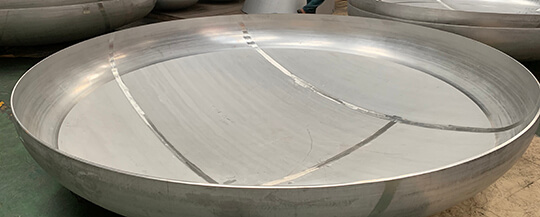When the factory inspected the head, it was found that a large number of dense, fine thread-like substances appeared on the inner surface. Through metallographic analysis and thermal stress analysis, it is determined that after its head is sensitized with multi-layer austenitic stainless steel, typical intergranular corrosion phenomena such as intergranular cracks and even partial grain shedding will occur in the subsequent head forming and service process.
Equipment overview
Type I pressure vessel: pressure is 0~750kPa(g), working temperature is 50~67℃. The medium is vinyl chloride monomer, peroxide, azo compound initiator, steam, etc. The medium contains chloride ions. Under certain conditions, it undergoes a hydrolysis reaction and dissolves in water to form hydrochloric acid. It is an intergranular corrosion medium for austenitic stainless steel. The inner diameter of the tank is 4500mm, the tank volume is 150m3, the cylinder and the head are both composite plates, the base material is 16MnR, and the composite material is 0Cr18Ni9. The lower head and the lower part of the cylinder are respectively equipped with agitators. The thickness of the head is 30+3mm, and the thickness of the cylinder is 28+3mm with agitator part and 16+3mm without agitator.
The head is a standard ellipse with an inner diameter of 4500mm. The composite plate is made of a normalized 30mm thick 16MnR plate and a solid solution 3.1mm thick 0Cr18Ni9 plate explosively composited. After the composite, the normalizing temperature heat treatment (920±10℃ heat preservation) 60min, out of the furnace, air cooling) to eliminate the explosion stress.
Corrosion status
Ultrasonic thickness measurement shows that the cylinder and the head are not thinned or the thinning is not obvious, indicating that the uniform corrosion is not obvious. Penetration inspection found no cracks on the inner wall of the cylinder, sporadic small lines on the inner wall of the upper head, and large areas of dense small lines on the lower head, suspected to be micro-cracks. Appears in the entire area of the head, where the distribution from the straight edge to the arc transition section of the head is more concentrated.
Cause analysis of sensitization
Review the forming and heat treatment of the head. After the blank preparation and tailor-welding are completed, the first heat treatment (600±20℃ for 80min, the furnace is cooled to 480℃ and then the furnace is air-cooled), then drum press molding, and then undergo intermediate heat treatment (the system is the same as the first time Heat treatment), then spinning forming, and finally heat treatment (heat preservation at 980℃ for 30min, forced air cooling to 400℃ within 22min).
The first heat treatment is to eliminate the welding stress, the intermediate heat treatment is to eliminate the deformation residual stress, and the final heat treatment is to eliminate the deformation residual stress and eliminate the sensitization of the austenitic stainless steel layer caused by the previous two heat treatments and restore its solid solution state.
Austenitic stainless steel has a sensitization zone at 540~845℃. When austenitic stainless steel is kept in this temperature zone, slowly heating up or cooling down, the supersaturated carbon in the austenite will combine with iron and chromium to synthesize compounds. The grain boundary precipitates and precipitates, which causes the area near the grain boundary to be depleted in chromium, and the grain boundary is in a state of being corroded first — a sensitized state. The 0Cr18Ni9 material has a risk of sensitization when kept at 650℃ for 10 minutes. The head cladding material has been severely sensitized after being kept at 600±20℃ for two times for 80 minutes. In the subsequent spinning forming process and use process, the head deforms greatly. In places (such as the arc transition section), cracks and intergranular corrosion are prone to initiation. The final heat treatment adopts a system of holding 980°C for 30 minutes and forced air cooling to 400°C within 22 minutes, hoping to eliminate the sensitization of the multi-layer stainless steel and restore it to a solid solution state.
